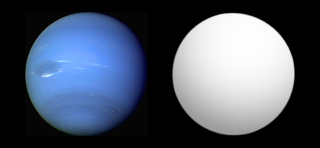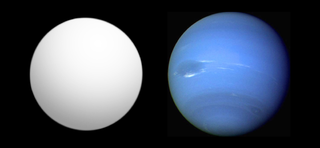
Kepler-4b, initially known as KOI 7.01, is an extrasolar planet first detected as a transit by the Kepler spacecraft. Its radius and mass are similar to that of Neptune; however, due to its proximity to its host star, it is substantially hotter than any planet in the Solar System. The planet's discovery was announced on January 4, 2010, in Washington, D.C., along with four other planets that were initially detected by the Kepler spacecraft and subsequently confirmed by telescopes at the W.M. Keck Observatory.

Kepler-5b is one of the first five planets discovered by NASA's Kepler spacecraft. It is a Hot Jupiter that orbits a subgiant star that is more massive, larger, and more diffuse than the Sun is. Kepler-5 was first flagged as the location of a possibly transiting planet, and was reclassified as a Kepler Object of Interest until follow-up observations confirmed the planet's existence and many of its characteristics. The planet's discovery was announced at a meeting of the American Astronomical Society on January 4, 2010. The planet has approximately twice the mass of Jupiter, and is about 1.5 times larger. It is also fifteen times hotter than Jupiter. Kepler-5b orbits Kepler-5 every 3.5 days at a distance of approximately 0.051 AU.

Kepler-8b is the fifth of the first five exoplanets discovered by NASA's Kepler spacecraft, which aims to discover planets in a region of the sky between the constellations Lyra and Cygnus that transit their host stars. The planet is the hottest of the five. Kepler-8b was the only planet discovered in Kepler-8's orbit, and is larger than Jupiter. It orbits its host star every 3.5 days. The planet also demonstrates the Rossiter–McLaughlin effect, where the planet's orbit affects the redshifting of the spectrum of the host star. Kepler-8b was announced to the public on January 4, 2010 at a conference in Washington, D.C. after radial velocity measurements conducted at the W.M. Keck Observatory confirmed its detection by Kepler.

Kepler-9 is a sunlike star in the constellation Lyra. Its planetary system, discovered by the Kepler Mission in 2010 was the first detected with the transit method found to contain multiple planets.

Kepler-9b is one of the first planets discovered outside the solar system (exoplanets) by NASA's Kepler Mission. It revolves around the star Kepler-9 within the constellation Lyra. Kepler-9b is the largest of three planets detected in the Kepler system by transit method; its mass is roughly half that of the planet Saturn, and it is the largest planet in its system. Kepler-9b and Kepler-9c display a phenomenon called orbital resonance, in which gravitational pull from each planet alters and stabilizes the orbit of the other. The planet's discovery was announced on August 26, 2010.

Kepler-9c is one of the first seven extrasolar planets, exoplanets, discovered by NASA's Kepler Mission, and one of at least two planets orbiting the star Kepler-9. Kepler-9c and Kepler-9b were the first exoplanets confirmed to be transiting their star. The planet's discovery was announced by the Kepler Mission team on August 26, 2010 after its initial discovery by Kepler. At the time, it was one of 700 planetary candidates noted by Kepler.

Kepler-10b is the first confirmed terrestrial planet to have been discovered outside the Solar System by the Kepler Space Telescope. Discovered after several months of data collection during the course of the NASA-directed Kepler Mission, which aims to discover Earth-like planets crossing in front of their host stars, the planet's discovery was announced on January 10, 2011. Kepler-10b has a mass of 3.72±0.42 Earth masses and a radius of 1.47 Earth radii. However, it lies extremely close to its star, Kepler-10, and as a result is too hot to support life as we know it. Its existence was confirmed using measurements from the W.M. Keck Observatory in Hawaii.

Kepler-10, formerly known as KOI-72, is a Sun-like star in the constellation of Draco that lies 607 light-years from Earth. Kepler-10 was targeted by NASA's Kepler spacecraft, as it was seen as the first star identified by the Kepler mission that could be a possible host to a small, transiting exoplanet. The star is slightly less massive, slightly larger, and slightly cooler than the Sun; at an estimated 11.9 billion years in age, Kepler-10 is almost 2.6 times the age of the Sun.

Kepler-10c is an exoplanet orbiting the G-type star Kepler-10, located around 608 light-years away in Draco. Its discovery was announced by Kepler in May 2011, although it had been seen as a planetary candidate since January 2011, when Kepler-10b was discovered. The team confirmed the observation using data from NASA's Spitzer Space Telescope and a technique called BLENDER that ruled out most false positives. Kepler-10c was the third transiting planet to be confirmed statistically, after Kepler-9d and Kepler-11g. The Kepler team considers the statistical method that led to the discovery of Kepler-10c as what will be necessary to confirm many planets in Kepler's field of view.

Kepler-11d is an exoplanet discovered in the orbit of the sun-like star Kepler-11. It is named for the telescope that discovered it, a NASA spacecraft named Kepler that is designed to detect Earth-like planets by measuring small dips in the brightness of their host stars as the planets cross in front. This process, known as the transit method, was used to note the presence of six planets in orbit around Kepler-11, of which Kepler-11d is the third from its star. Kepler-11d orbits Kepler-11 well within the orbit of Mercury approximately every 23 days. The planet is approximately six times more massive than the Earth, and has a radius that is three and a half times larger than that of Earth's. It is, however, far hotter than Earth is. Its low density, comparable to that of Saturn, suggests that Kepler-11d has a large hydrogen–helium atmosphere. Kepler-11d was announced with its five sister planets on February 2, 2011 after extensive follow-up studies.

Kepler-11e is an exoplanet discovered in the orbit of the sunlike star Kepler-11. It is the fourth of six planets around Kepler-11 discovered by NASA's Kepler spacecraft. Kepler-11e was found by using the transit method, in which the dimming effect that a planet causes as it crosses in front of its star is measured. Kepler-11e is most likely a gas giant like Neptune, having a density that is less than that of Saturn, the least dense planet in the Solar System. Its low density can probably be attributed to a large hydrogen and helium atmosphere. Kepler-11e has a mass eight times of Earth's mass and a radius 4.5 times that of Earth. The planet orbits its star every 31 days in an ellipse that would fit within the orbit of Mercury. Kepler-11e was announced on February 2, 2011 with its five sister planets after it was confirmed by several observatories.

Kepler-11f is an exoplanet discovered in the orbit of the sun-like star Kepler-11 by NASA's Kepler spacecraft, which searches for planets that transit their host stars. Kepler-11f is the fifth planet from its star, orbiting one quarter of the distance of the Earth from the Sun every 47 days. It is the furthest of the first five planets in the system. Kepler-11f is the least massive of Kepler-11's six planets, at nearly twice the mass of Earth; it is about 2.6 times the radius of Earth. Along with planets d and e and unlike the two inner planets in the system, Kepler-11f has a density lower than that of water and comparable to that of Saturn. This suggests that Kepler-11f has a significant hydrogen–helium atmosphere. The Kepler-11 planets constitute the first system discovered with more than three transiting planets. Kepler-11f was announced to the public on February 2, 2011, after follow-up investigations at several observatories. Analysis of the planets and study results were published the next day in the journal Nature.

Kepler-11g is an exoplanet discovered in the orbit of the sunlike star Kepler-11 by the Kepler spacecraft, a NASA satellite tasked with searching for terrestrial planets. Kepler-11g is the outermost of the star's six planets. The planet orbits at a distance of nearly half the mean distance between Earth and the Sun. It completes an orbit every 118 days, placing it much further from its star than the system's inner five planets. Its estimated radius is a little over three times that of Earth, i.e. comparable to Neptune's size. Kepler-11g's distance from the inner planets made its confirmation more difficult than that of the inner planets, as scientists had to work to exhaustively disprove all reasonable alternatives before Kepler-11g could be confirmed. The planet's discovery, along with that of the other Kepler-11 planets, was announced on February 2, 2011. According to NASA, the Kepler-11 planets form the flattest and most compact system yet discovered.
Kepler-12b is a hot Jupiter that orbits G-type star Kepler-12 some 900 parsecs (2,900 ly) away. The planet has an anomalously large radius that could not be explained by standard models at the time of its discovery, almost 1.7 times Jupiter's size while being 0.4 times Jupiter's mass. The planet was detected by the Kepler spacecraft, a NASA project searching for planets that transit their host stars. The discovery paper was published on September 5, 2011.

Kepler-20f (also known by its Kepler Object of Interest designation KOI-070.05) is an exoplanet orbiting the Sun-like star Kepler-20, the second outermost of five such planets discovered by NASA's Kepler spacecraft. It is located approximately 929 light-years (285 parsecs, or about 8.988×1015 km) from Earth in the constellation Lyra. The exoplanet was found by using the transit method, in which the dimming effect that a planet causes as it crosses in front of its star is measured. The planet is notable as it has the closest radius to Earth known so far.

Kepler-47c is an exoplanet orbiting the binary star system Kepler-47, the outermost of three such planets discovered by NASA's Kepler spacecraft. The system, also involving two other exoplanets, is located about 3,400 light-years away.

Kepler-62e is a super-Earth exoplanet discovered orbiting within the habitable zone of Kepler-62, the second outermost of five such planets discovered by NASA's Kepler spacecraft. Kepler-62e is located about 990 light-years from Earth in the constellation of Lyra. The exoplanet was found using the transit method, in which the dimming effect that a planet causes as it crosses in front of its star is measured. Kepler-62e may be a terrestrial or ocean-covered planet; it lies in the inner part of its host star's habitable zone.
Kepler-62c is an approximately Mars-sized exoplanet discovered in orbit around the star Kepler-62, the second innermost of five discovered by NASA's Kepler spacecraft around Kepler-62. At the time of discovery it was the second-smallest exoplanet discovered and confirmed by the Kepler spacecraft, after Kepler-37b. It was found using the transit method, in which the dimming that a planet causes as it crosses in front of its star is measured. Its stellar flux is 25 ± 3 times Earth's. It is similar to Mercury.

Kepler-438b is a confirmed near-Earth-sized exoplanet. It is likely rocky. It orbits on the inner edge of the habitable zone of a red dwarf, Kepler-438, about 472.9 light-years from Earth in the constellation Lyra. It receives 1.4 times our solar flux. The planet was discovered by NASA's Kepler spacecraft using the transit method, in which the dimming effect that a planet causes as it crosses in front of its star is measured. NASA announced the confirmation of the exoplanet on 6 January 2015.

Kepler-442b is a confirmed near-Earth-sized exoplanet, likely rocky, orbiting within the habitable zone of the K-type main-sequence star Kepler-442, about 1,206 light-years (370 pc) from Earth in the constellation of Lyra.





















